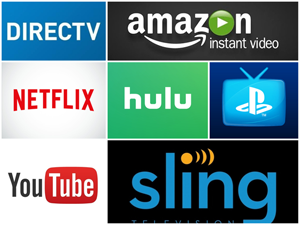SVoD and Your Shrinking Bandwidth
SVoD – Streaming/Subscription Video on Demand
Over Your Shrinking Bandwidth
The importance of ample and reliable bandwidth for your business has always been a major concern. It was not so many years ago, that businesses were upgrading their dial-up modem connections from 19K to 56K. Then bonding several T1s together seemed like all the speed in the world. But the world does change.
As a business decision maker, you are finding out that online video consumption is one of the most popular internet activities worldwide, and its shrinking your bandwidth in gobs of ways in your own back yard. According to recent industry data, online video market penetration is practically everywhere in all the leading online markets. Saudi Arabia is leading at a 98 percent online video usage reach as of January 2017. In 2020, the number of digital video viewers in the United States is projected to surpass 232 million, which means over 70% of the US will be watching video and consuming larger buckets of bandwidth.
TODAY… Current market data states that many internet users consume online video every day, with 36 percent of U.S. internet users doing so. Google Sites, which include YouTube, are ranked at the top of U.S. online video properties, currently attracting a steady minimum of 188 million unique viewers per month. Other popular U.S. video sites are Yahoo! Screen, Vimeo, VEVO and Dailymotion, which stand out due to user engagement or number of streams. With the increasing usage of mobile devices such as smartphones and tablets, the current worldwide mobile video traffic is also estimated to amount to 4.4 million TB per month. The number of mobile phone video viewers in the United States is projected to reach 179 million in 2020. Currently, viewers aged 18 to 24 spend the most time on smartphone video content – 165 minutes per week is the average.
Apart from popular video content platforms, several Streaming or Subscription-Video-on-Demand (SVoD) companies have become a major brand name in paid streaming content with Netflix being the most well-known. Netflix’s 2017 revenue amounted to $11.63 billion U.S. dollars. As most of us know, Netflix has also started to produce original content to compete with most of the other content sources. Other popular SVoD providers in the United States are Amazon Prime Video and Hulu. But let’s not forget HBO and it’s like channels are starting to move to SVoD also. In total, 37 percent of TV viewers in the United States use streaming services to watch digital video content on their TV. The growth is augmented with social media sites like Facebook starting to dip a toe into the SVoD world with their own produced content as well.
Digital video advertising has also been a growing trend in the United States and is projected to reach 14.38 billion U.S. dollars in 2019. Viral video marketing, as well as online video sharing are two important factors in the quickly expanding market. Brands have also started to take advantage of the video medium and producing brand videos and digital content. The most-followed brand channels on YouTube include LEGO, Vat19 and Red Bull. Red Bull was also the most social video brand in 2016, having accumulated over 27 million social media content shares. 2017 numbers are coming in, and social video sited belonging to Wendy’s, General Electric, and Disney are leading the ever changing pack.
 More and more businesses are installing SVoD service providers who offer many options including local news channels. This may help businesses with weather and other local issues, but it also opens up your bandwidth to more users as well. AT&T Directv, Directv Now, SlingTV, Roku, Playstation Vue, Amazon and Apple TV are also bandwidth gobblers in the business sector.
More and more businesses are installing SVoD service providers who offer many options including local news channels. This may help businesses with weather and other local issues, but it also opens up your bandwidth to more users as well. AT&T Directv, Directv Now, SlingTV, Roku, Playstation Vue, Amazon and Apple TV are also bandwidth gobblers in the business sector.
So, what does all this mean to you? Your business (and home) bandwidth is being chewed up by not only your day-to-day operations but by an ever-increasing thirst for more video content by everyone you know!
Considerations
- Make sure you have ample Internet bandwidth both up and down speeds
- Make sure you have reliable Internet bandwidth like Fiber
- Make sure you have a secondary or redundant Internet bandwidth
- Make sure you have tight security on your Internet bandwidth
- Make sure you have eyes on your over-users of Internet bandwidth
- Make sure you work within the allotted consumption of Internet bandwidth to avoid overages
- Make sure you have an experienced team to manage everything… Like maybe… Metropark!!